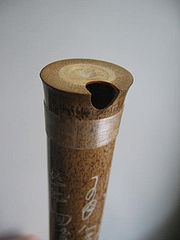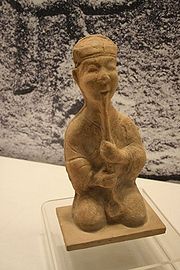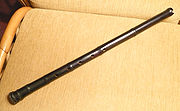
Xiao (flute)
Encyclopedia




End-blown flute
The end-blown flute or rim-blown flute is a keyless woodwind instrument played by directing an airstream against the sharp edge of the upper end of a tube. Unlike a recorder or tin whistle, there isn't a ducted flue voicing, also known as a fipple. Most rim-blown flutes are "oblique" flutes, being...
. It is generally made of dark brown bamboo
Bamboo
Bamboo is a group of perennial evergreens in the true grass family Poaceae, subfamily Bambusoideae, tribe Bambuseae. Giant bamboos are the largest members of the grass family....
(called "purple bamboo" in Chinese). It is also sometimes (particularly in Taiwan
Taiwan
Taiwan , also known, especially in the past, as Formosa , is the largest island of the same-named island group of East Asia in the western Pacific Ocean and located off the southeastern coast of mainland China. The island forms over 99% of the current territory of the Republic of China following...
) called dòngxiāo , dòng meaning "hole." An ancient name for the xiāo is shùdí (豎笛, lit. "vertical bamboo flute", ʂûtǐ) but the name xiāo in ancient times also included the side-blown bamboo flute, dizi.
The xiāo is a very ancient Chinese instrument usually thought to have developed from a simple end-blown flute used by the Qiang people of Southwest China
Southwest China
Southwest China is a region of the People's Republic of China defined by governmental bureaus that includes the municipality of Chongqing, the provinces of Sichuan, Yunnan and Guizhou, and the Tibet Autonomous Region.-Provinces:-Municipalities:...
. The modern six-hole form of the instrument goes back to the Ming Dynasty
Ming Dynasty
The Ming Dynasty, also Empire of the Great Ming, was the ruling dynasty of China from 1368 to 1644, following the collapse of the Mongol-led Yuan Dynasty. The Ming, "one of the greatest eras of orderly government and social stability in human history", was the last dynasty in China ruled by ethnic...
.
Organology
Xiao are today most often pitched in the key of G (with the D above middle C being the lowest note, with all fingers covered), although xiao in other less common keys are also available, most commonly in the key of F. More traditional xiao have six finger holes, while most modern ones have eight; the additional holes do not extend the instrument's range but instead make it easier to play notes such as F natural. There are a further four (sometimes two or six) sound holes situated at the bottom third of the length of the xiao. The blowing hole is at the top end, it may be cut into a 'U' shape, a "V" shape, or at an angle (with or without bone/ivory inlay.) Some xiao have the blowing end entirely cut off, so the player must use the space between their chin and lips to cover the hole fully. There may be a metal joint between the blow hole and the top finger hole for tuning purposes and sometimes also between the last finger hole and the end. The length of the xiao ranges from around 45 cm to over 1.25 m but is usually around 75–85 cm. Usually, shorter xiaos are more difficult to play because of the need to control one's breath more accurately. The angle to play the xiao is around 45 degrees from the body.Varieties of xiao
The qinxiao or 紫竹箫 (pinyin:“Zi Zhu Xiao") is a version of the xiao, which is narrower and generally in the key of F with eight finger holes, used to accompany the guqinGuqin
The guqin is the modern name for a plucked seven-string Chinese musical instrument of the zither family...
. The narrowness of the qin xiao makes the tone softer, making it more suitable to play with the qin (which is a very quiet instrument). It is also the longest of all xiao types, up to 1.25m.
The nanxiao , "Southern xiao") or 洞箫(pinyin: "Dong Xiao"), sometimes called chiba
Chiba
-Places:* Chiba, Chiba, capital city of Chiba Prefecture, Japan* Chiba Prefecture, a sub-national jurisdiction in the Greater Tokyo Area on the eastern coast of Honshū Island, Japan* Chiba Station, a train station in Chiba, Chiba...
' onMouseout='HidePop("19162")' href="/topics/Shakuhachi">shakuhachi
Shakuhachi
The is a Japanese end-blown flute. It is traditionally made of bamboo, but versions now exist in ABS and hardwoods. It was used by the monks of the Fuke school of Zen Buddhism in the practice of...
) is a short xiao with open blowing end used in the Nanyin
Nanyin
Nanyin may refer to:*Empress Yang Zhi, nickname*Nanguan , a style of Chinese classical music*Nanguan District, in Changchun, Jilin, China...
, the local Fujianese opera from Quanzhou
Quanzhou
Quanzhou is a prefecture-level city in Fujian province, People's Republic of China. It borders all other prefecture-level cities in Fujian but two and faces the Taiwan Strait...
.
Related instruments
A separate instrument, the paixiaoPaixiao
The paixiao is an ancient Chinese wind instrument, a form of pan pipes. It is no longer used, having died out in ancient times, although in the 20th century it was reconstructed...
is a panpipe which was used in ancient China and which, although it remains unusual, has recently had something of a come-back.
The Japanese shakuhachi
Shakuhachi
The is a Japanese end-blown flute. It is traditionally made of bamboo, but versions now exist in ABS and hardwoods. It was used by the monks of the Fuke school of Zen Buddhism in the practice of...
and hocchiku
Hocchiku
, sometimes romanized as hocchiku or hochiku, is a Japanese end-blown flute , crafted from root sections of bamboo. After cleaning and sanding, the heavy root end of the bamboo stalk reveals many small circular knots where the roots formerly joined the stalk...
, and the Korean tungso
Tungso
The tungso is a Korean notched, end-blown vertical bamboo flute used in Korean traditional music. It is similar to the danso, but longer.The tungso is a vertical flute made of thick, aged bamboo...
and danso
Danso
The danso is a Korean notched, end-blown vertical bamboo flute used in Korean folk music. It is traditionally made of bamboo, but in the 20th century it has also been made of plastic....
(also spelled tanso), are descended from earlier forms of the Chinese xiao.
External links
- Xiao page from Paul and Bernice Noll site
See also
- Chinese flutesChinese flutesChinese flutes come in various types. They includeTransverse Flutes:*Dizi...
- End-blown fluteEnd-blown fluteThe end-blown flute or rim-blown flute is a keyless woodwind instrument played by directing an airstream against the sharp edge of the upper end of a tube. Unlike a recorder or tin whistle, there isn't a ducted flue voicing, also known as a fipple. Most rim-blown flutes are "oblique" flutes, being...
- Music of ChinaMusic of ChinaChinese Music has been made since the dawn of Chinese civilization with documents and artifacts providing evidence of a well-developed musical culture as early as the Zhou Dynasty...
- Traditional Chinese musical instrumentsTraditional Chinese musical instruments-The Eight Sounds or Eight Tones :The eight categories are: silk, bamboo, wood, stone, metal, clay, gourd and hide. There are other instruments which may not fit these classifications. This is one of the first musical classifications ever.-Silk :...
- ShakuhachiShakuhachiThe is a Japanese end-blown flute. It is traditionally made of bamboo, but versions now exist in ABS and hardwoods. It was used by the monks of the Fuke school of Zen Buddhism in the practice of...
- BambooBambooBamboo is a group of perennial evergreens in the true grass family Poaceae, subfamily Bambusoideae, tribe Bambuseae. Giant bamboos are the largest members of the grass family....

